Higher classification Urocissa Order Passerine | Genus Urocissa Phylum Chordata Rank Species | |
 | ||
Similar Bird, Urocissa, Red‑billed blue magpie, Crow family, Eurasian magpie | ||
The Taiwan blue magpie (Urocissa caerulea), also called the Taiwan magpie, Formosan blue magpie (Chinese: 臺灣藍鵲; pinyin: Táiwān lán què), or the "long-tailed mountain lady" (Chinese: 長尾山娘; pinyin: Chángwěi shānniáng; Taiwanese Hokkien: Tn̂g-boé soaⁿ-niû), is a species of bird of the crow family. It is endemic to Taiwan.
Contents
- Taiwan blue magpie enjoyed touching by birders
- Taxonomy and systematics
- Distribution and habitat
- Description
- Behavior
- Food and feeding
- Breeding
- Threats
- Relationship with humans
- Status
- References

Taiwan blue magpie enjoyed touching by birders
Taxonomy and systematics
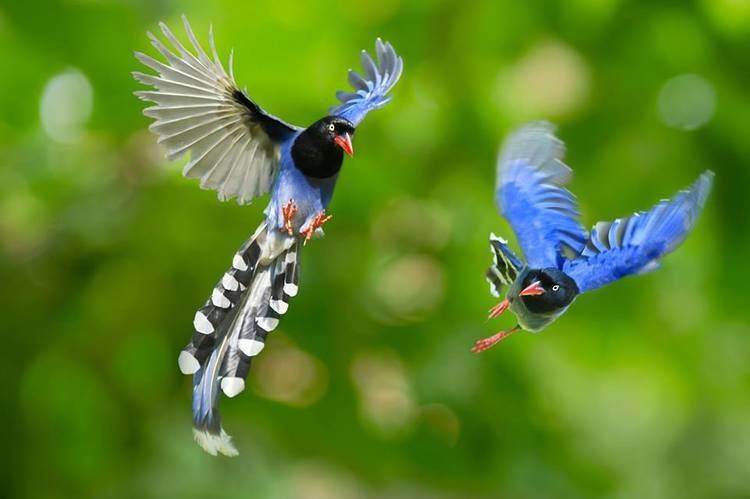
The Taiwan blue magpie was collected by Robert Swinhoe and described by John Gould. Swinhoe called it the "Long-tailed Mountain-Nymph". The Taiwan blue magpie is sometimes placed in the genus Cissa. It forms a superspecies with the yellow-billed blue magpie (Urocissa flavirostris) and the red-billed blue magpie (Urocissa erythroryncha). The species is monotypic.
Distribution and habitat
The Taiwan blue magpie is endemic to Taiwan. It lives in broadleaf forests at elevations of 300–1,200 m (980–3,940 ft).
Description
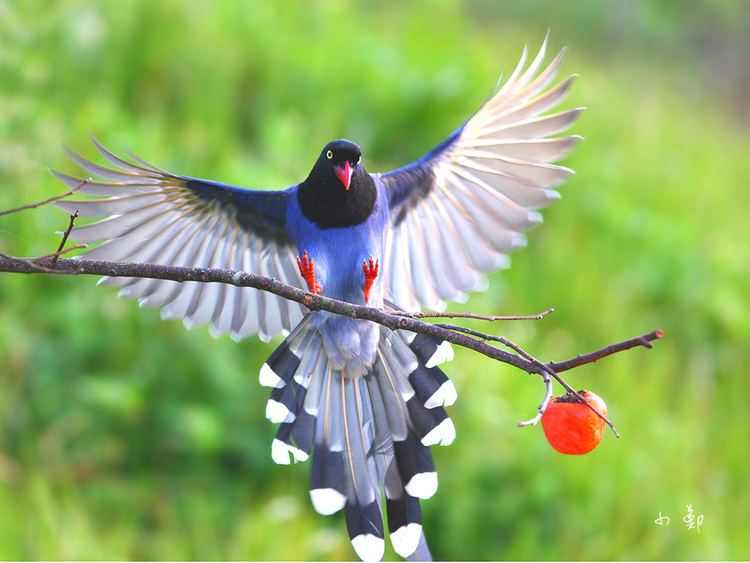
It is 63–68 cm (25–27 in) in length. The tail measures around 34–42 cm (13–17 in) in length. The wings are 20 cm (7.9 in) long. It weighs 254–260 g (9.0–9.2 oz).
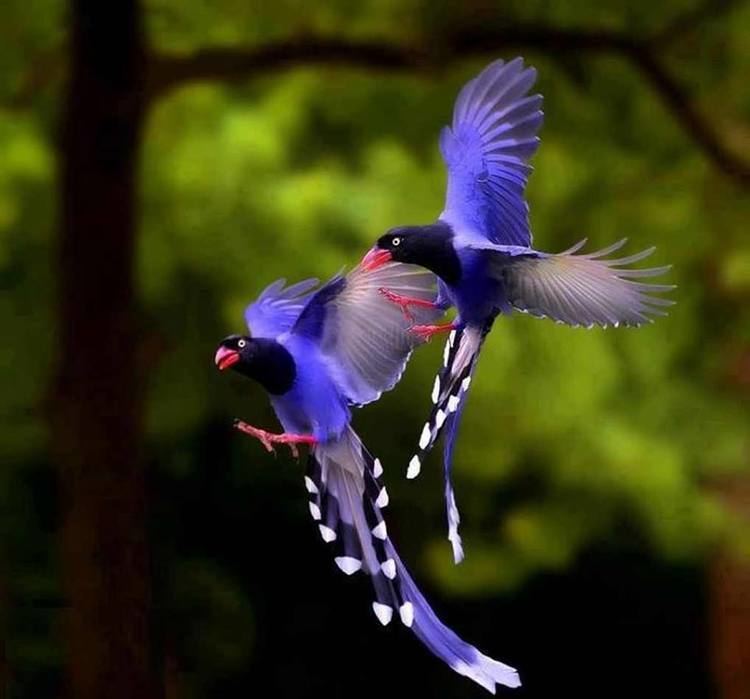
The plumages of the male and female are similar. The head, neck and breast are black. The eyes are yellow. The bill and feet are red. The rest of the plumage on the bird is mostly blue. The wings and tail feathers have white tips. The underwing-coverts are dark grey, and the flight feathers are light grey. The uppertail-coverts have black tips. The central pair of tail feathers are the longest. The other tail feathers have black bands. Chicks are greyish, with a short tail and greyish-blue eyes.
Behavior
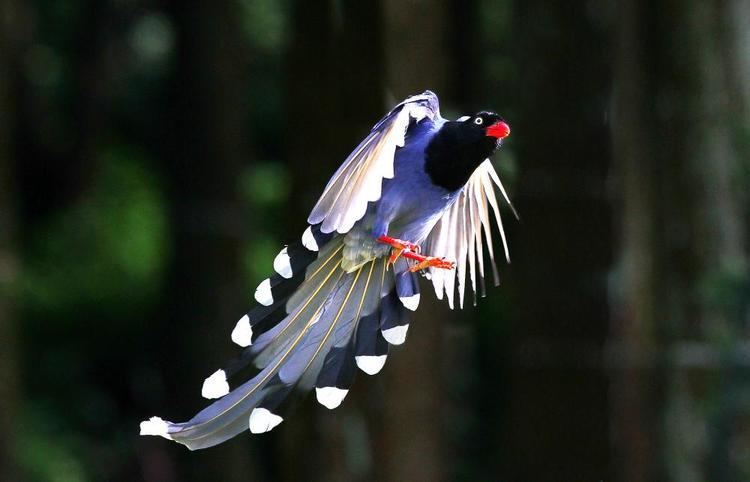
Taiwan blue magpies are not very afraid of people. They can be found near human residences in the mountains or newly cultivated lands. They are gregarious and are usually found in groups of three to twelve. The birds often fly in a line, following each other. This is sometimes called "long-tailed formation".
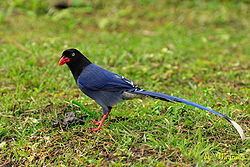
Similar to other members of the crow family, they have a raucous call which is described as a high-pitched cackling chatter, kyak-kyak-kyak-kyak. They also have calls like ga-kang, ga-kang, kwee-eep and gar-suee.
Food and feeding
Taiwan blue magpies are scavengers and omnivores. Their diet includes snakes, rodents, small insects, carrion, eggs and chicks of other birds, plants, fruits, and seeds. They also feed on food waste of humans. They sometimes store leftovers on the ground and cover them with leaves for future retrieval. Sometimes they store food in the leaves or branches.
Breeding
The breeding season is from March to July. The Taiwan blue magpie is monogamous. Females incubate eggs while males help with nest building and feeding. Their nests are built on high branches of trees. The nest is in the shape of a bowl and is made of twigs. Usually there are 3–8 eggs in a clutch. Eggs are light green in color, with brown marks. Hatching takes 17–19 days. There are 3–7 chicks per nest. Chicks leave the nest after 21–24 days. They can start flying for short distances after a few days. Some pairs breed a second time after this. The Taiwan blue magpie has helpers at the nest. Helpers are mostly juveniles from previous breeding seasons. They help to feed the chicks and defend the nest. Taiwan blue magpies have a strong nest defence behaviour, and will attack intruders until they leave.
Threats
Taiwan blue magpies may be hit by cars or captured by humans. They are also killed by predators, such as the crested goshawk.
Relationship with humans
Taiwan blue magpies have attacked humans to defend their nests. Taiwan blue magpies are sometimes illegally captured by humans, but the number of cases of this seems to have decreased.
In the 2007 National Bird Voting Campaign held by the Taiwan International Birding Association, there were over 1 million votes cast from 53 countries. The Taiwan blue magpie defeated the Mikado pheasant in the vote, but the vote was not formally accepted.
Status
The IUCN Red List of Threatened Species has currently assessed the species to be of least concern as it does not meet the criteria to be vulnerable. The population trend is suspected to be stable. Due to its endemism, however, the Taiwan blue magpie has been listed as other convervation-deserving wildlife (Chinese: 其他應予保育之野生動物) and protected by Taiwan's Wildlife Conservation Act (Chinese: 野生動物保育法).
There is a small population of red-billed blue magpies that has been introduced to Wuling Farm in Taichung County (now part of Taichung City). In 2007, three hybrid chicks were found in a nest in Taichung, with red-billed and Taiwan magpie parents tending them. This caused some concern to conservationists, given the decline of the Taiwan hwamei due to the invasion of the Chinese hwamei. However, the Endemic Species Research Institute of Taiwan has been working to control red-billed magpie populations by capturing individual birds and relocating their nests.
